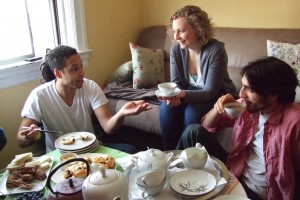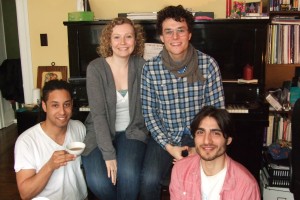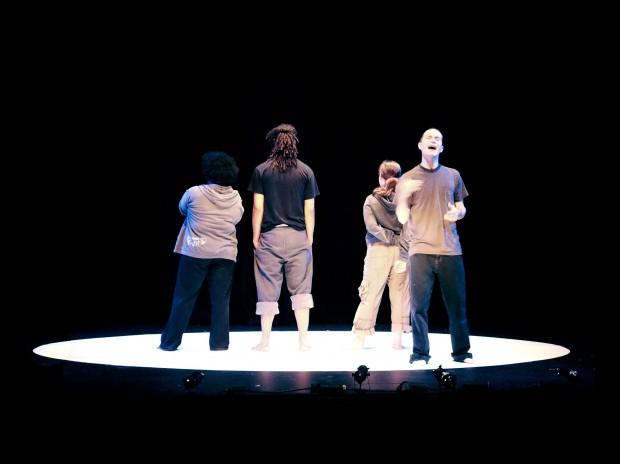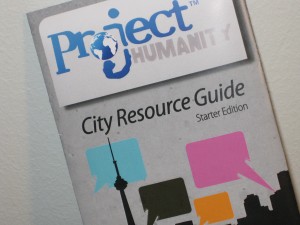Tea with D’Agostino (let’s not talk about theatre) – Project: Humanity
by Melissa D’Agostino
Welcome to Tea with D’Agostino, an interview series where members of Toronto’s theatre community come over to my place for tea and homemade treats, and we sit around to not talk about theatre. That’s right: theatre artists not talking about theatre. It’s time.
My inaugural interview is with the core members of Project: Humanity who recently doubled their goal to raise 5000 tokens for Youth Without Shelter in Rexdale through a massive campaign that took over TTC Subway stations called Tokens4Change. They managed to raise 10,000 tokens and raise awareness through live performances by both youth and professionals within the subway stations, as well as a texting campaign that is still active (text TOKENS to 45678 to donate).
They also recently opened The Middle Place at Canadian Stage, a piece of verbatim theatre written by Andrew Kushnir based on on-camera interviews with the residents of Youth Without Shelter. The Middle Place is a product of the De-Shelter Initiative they began in 2007, and is the inaugural project emerging from the community work they are currently engaged in.
I sat down with Andrew, Dan, Antonio and Catherine for some tea.
On the menu today:
Teas: Cream of Earl Grey, Forbidden Fruit, Bravissimo
Treats: Homemade blueberry scones and finger sandwiches
 Melissa: Thanks for doing this, folks.
Melissa: Thanks for doing this, folks.
Andrew: No problem. We want to win the trip
Melissa: Oh right, one of the interview groups wins an all expenses paid trip to the Bahamas.
Andrew: Really? That’s great.
Melissa: Yeah. This is a theatre blog so we have lots of money!
Catherine: I can’t remember the last time I had a cucumber sandwich.
Antonio: Um…quarter past never.
On effecting social change:
Melissa: Now, your company started out wanting to effect local and global change, but you seemed to have shifted your focus more on the local. We’ve talked before, Antonio and I, about how my personal feeling is that that’s how you create global change, through the local. Do you think there’s another way for you to move into having a more global, or national, or wider affect through the work that you do, or if you see the local as the stepping stone to that?
Antonio: I don’t really think you can be here and affect things globally without being there. Does that make sense? I’m not totally interested in sending relief, I’m interested in knowing what the culture is around you and figuring out who you are in that ecosystem, and figuring out how you can be a better you, and help people be a better them, and help people develop their own skills and resources. So if I had the money and the this and the that, I would say ‘Here’s a parachute Dan, we’re going to drop you off in this place, go set up a headquarters and make a whole new team that works elsewhere’, and then once you’re there start fixing things locally. It’s still global change and global awareness, but it’s from a local sensibility.
Melissa: So you’re taking the language that you’ve created as a company, or the…
Antonio: the methods…
Melissa: right, but then tailoring it to that community?
Dan: Yeah, like, what are the fundamental principles behind what we’re doing? And I think our principles and our approach to the work we’re doing is what forced us to be local. What we found, as we tried to do things and approach things authentically, what we found actually connected was local, because that’s what we had access to. But, even in being ‘local’, we are still entering a community that’s not our community. So our approach still has to do with getting to know the community, finding out what their needs are, how we can fit in, how we can be helpful—so our result is from that process of getting to know that community.
Antonio: We are interested in saying ‘What is our conversation with this community, and what am I bringing to it and what are they bringing to it?’
On Justin Bieber & Swagger Coaching:
Andrew: Can we talk about Justin Bieber?
(Laughter)
Melissa: Actually I was going to ask you about Bieber.
Antonio: Really?
Melissa: Yeah. We can’t talk about theatre, so…
Andrew: Well there are these two things that are going to come out in this Rolling Stone article—
Antonio—is it out already?
Andrew: It may be out already. He says abortion is wrong, and arguably under any circumstances—so they asked, ‘What if somebody was raped’, and he sort of said, I’m paraphrasing, ‘Everything happens for a reason’.
Antonio: Yeah, I read it though.
Andrew: You read the actual interview?
Antonio: That’s why I thought it was out already.
Melissa: I think it is out.
Antonio: I just feel like, ‘cause I’ve heard a couple people say ‘Justin Bieber thinks abortion is wrong’, and the other half of that sentence is, ‘I’ve never been in a situation like that and I’m not judging anybody’, so…
Dan: And I think that’s an important side to it.
Antonio: It is!
Dan: I mean are we actually looking to a twelve year old for our worldviews?
Andrew: He’s not twelve.
Dan: Well-
 Catherine: He’s 16. He doesn’t even know how to have sex yet.
Catherine: He’s 16. He doesn’t even know how to have sex yet.
Andrew: His music would suggest that he is a fantastic love maker.
(Laughter)
Andrew: He also makes a comment about gay people in that interview, and I think maybe this is being spun in a certain way, but, he says it’s a person’s decision whether they are gay or not. So people have pounced on that because is he saying—does he think that homosexuality is a choice, which would be a terrible idea to advance.
Antonio: Sure.
Catherine: But if he’s coming from the religious background that the abortion comments come from—
Antonio: No, he’s from Stratford.
Catherine: His family’s very religious. He’s all about God gave me this, God is bringing me this way, so if that’s the background from which he’s coming, at 16 years old when you do not understand action versus consequence, the world’s bigger picture, all of these things, then it’s just doctrine, right?
Antonio: He’s a kid, right? So he says things the way they come out.
Andrew: And frankly, he can have whatever view he wants. I don’t actually care what his view is.
Dan: Well—
Andrew: It would significantly alter my appreciation for him as a, you know…
Antonio: You might return the album?
(Laughter)
Melissa: (to Andrew, and somewhat surprised) do you like Justin Bieber? Are you a fan?
Andrew: I’m actually more impressed by Jaden Smith. I think he’s a good little actor, and he’s got that, what’s that called that Bieber had? Not a ‘strut coach’ but a –
Antonio: Swagger?
Andrew: Yeah, like a ‘Swagger Coach’
Antonio: Oh my God! Why do I not have that job?
Andrew: I know.
Antonio: I could be a Swagger Coach.
Dan: Yeah.
Melissa: But do you like the ‘Swagger’? I find it so fake. He was on Ellen and they were dancing, and he wasn’t dancing. He was posing.
Antonio: I find a lot of his dance moves suspect. They’re very weird. He’s not a good dancer, so when he does them it looks like he’s punching the air. It’s like punch the air, kick the tiger, turn, turn.
Melissa: Kick the tiger?
Andrew: Isn’t it like the Michael Jackson ‘distract the tiger, kick the tiger move’?
Melissa: Wow, I am clearly missing out on Bieber’s moves.
On Distracting the Tiger:
______________________________________________________________________
 The Middle Place runs until March 12th at the Berkeley St. Theatre. Click here for tickets and info.
The Middle Place runs until March 12th at the Berkeley St. Theatre. Click here for tickets and info.
To make a $5 donation to Tokens4Change, and help raise even more tokens for Youth Without Shelter, text TOKENS to 45678. For more information visit www.tokens4change.com or www.projecthumanity.ca.
Melissa D’Agostino is an award-winning actor, writer, singer and producer. She also likes tea. Check her out at www.melissadagostino.net






Recent Comments